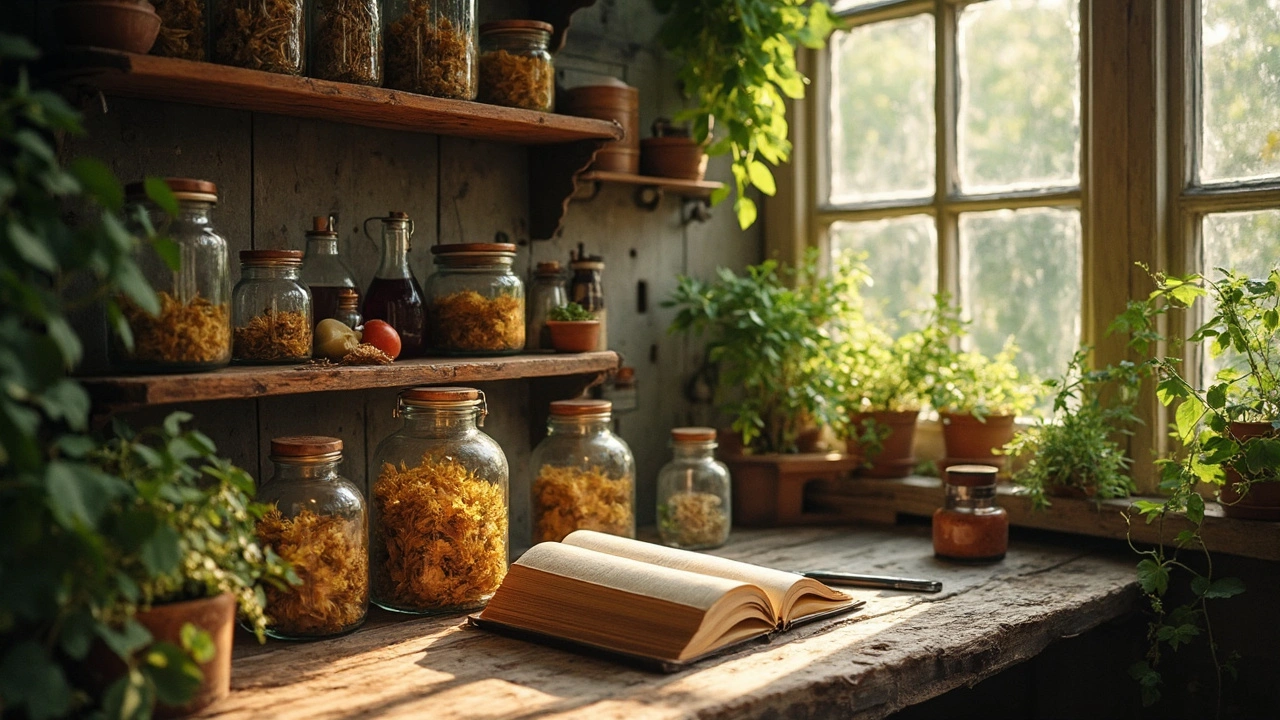Some plants carry legends wherever they go. Golden ragwort isn’t exactly mainstream, but if you’re into wildflowers or herbal remedies, you’ve probably stumbled across this yellow beacon while walking a damp trail or poking around your grandma's garden. Whispers of this wildflower’s healing touch have drifted through communities for centuries, but what’s fact and what’s wishful thinking? Golden ragwort, or Senecio aureus, deserves a place in today’s supplement aisle, and not just as another pretty face.
Meet Golden Ragwort: More Than a Pretty Wildflower
Golden ragwort jumps out at you—bright, almost cartoon-yellow blooms on top of long, elegant stems, turning damp woodland patches into a wild, golden sea every spring. Native all across North America, this plant was a star in folk medicine chests long before anyone shuffled into a pharmacy for ibuprofen. Native tribes used it for menstrual discomfort, reproductive health, and even as a topical for wounds. Early settlers leaned on its leaves for the same reasons when pharmacies were still a luxury.
But let’s be honest: For most people today, golden ragwort is that mysterious flower you can’t quite name at the edge of a marsh, maybe vaguely associated with herbal tea blends. Here’s where it gets fascinating: golden ragwort has a rich chemical profile. The leaves and flowers are flowing with flavonoids, alkaloids, and terpenoids. The plant contains compounds like senecionine and other pyrrolizidine alkaloids, which scientists have found can influence everything from inflammation to menstrual problems. Some molecules in golden ragwort resemble those in better-known medicinal plants like feverfew and yarrow.
People often worry about the toxicity of ragwort, mostly from horror stories about livestock. But toxicity is always about the dose and the preparation. The exact same plant that’s dangerous to a grazing sheep is processed very differently in tiny doses for a human supplement. Modern supplement companies standardize and purify extracts, keeping the benefits while reducing the risk. Always check that you’re getting your golden ragwort from companies that test and certify their products.
Here’s a fun fact: the American Eclectic physicians—think 19th-century herbal doctors—swore by golden ragwort under the name "life root," mainly as a tonic for women. Herbal books from the 1800s cite its use in balancing menstruation, supporting pregnancy, and helping with postpartum recovery. It’s increasingly being researched by contemporary herbalists who love comparing age-old plant lore with hard science.
Next time you see a patch of golden ragwort, remember: it's not just decoration. It’s a living link to how people cared for each other, naturally, for generations.
What Science Says About Golden Ragwort’s Health Benefits
People often wonder, does golden ragwort actually work, or is this just another piece of folklore? Well, the science is playing catch-up with tradition, but some facts stand out. Modern research focuses mostly on the plant's anti-inflammatory, antioxidant, and hormone-balancing abilities. The most promising studies come out of labs testing extracts for their ability to fight inflammation, which is central to so many chronic health issues.
Golden ragwort’s pyrrolizidine alkaloids are a mixed bag—they have powerful effects but can be harmful if overused or poorly prepared. That’s why modern supplements use standardized extracts, keeping alkaloid levels safe but ensuring the body still gets those interesting plant constituents. Some small laboratory studies show golden ragwort reduces inflammatory markers in cell models and rodent studies, suggesting it could soothe sore muscles, support joint health, or help tame runaway inflammation like that in autoimmune conditions.
The plant’s flavonoids and terpenoids have shown free radical-scavenging properties, protecting your cells against the damage that leads to aging or disease. Some researchers are even looking at its potential to support healthy circulation by relaxing blood vessels and helping maintain normal blood flow. There’s also a historic reputation for supporting women’s health—think hormone swings, PMS, menopause. While clinical trials in humans are limited, some practitioners draw from a blend of research and traditional wisdom to suggest golden ragwort for those dealing with heavy periods or uncomfortable cycles.
And about wound healing: historical records talk about golden ragwort’s use on scrapes or inflamed skin. Its anti-inflammatory punch probably explains why. You won’t find a big double-blind clinical trial on this just yet, but the traditional uses line up with what scientists are discovering in the chemistry lab. One herbalist I spoke to called it “a plant for life transitions—especially for anyone needing a little extra resilience.” That sums it up pretty well.
You’ll hear voices of caution, and that’s smart with any wild plant. The golden ragwort supplements you buy should be certified and sourced responsibly.
"Herbal medicine’s power is often in nuance and tradition, not just big clinical trials. What matters is observation and respect for the plant’s potential—and limitations," says Mark Blumenthal, founder of the American Botanical Council.

How to Use Golden Ragwort Safely: Tips for Modern Day Supplements
If you’re curious about bringing golden ragwort into your routine, you’ve got options. Most people reach for capsules or tinctures—basically, concentrated liquid extracts—that take out the “wild guessing” about dose and purity. A handful of companies offer teas, but your best bet for consistency and safety are products from established herbal supplement makers.
Always start with a low dose. Adults often take golden ragwort as a daily tonic, usually a single capsule or 15–30 drops of tincture, but follow the directions on your bottle and check with an herbalist or health professional first. Pregnant or breastfeeding? This is one of those herbs to run past your doctor before trying, as traditional use doesn’t always translate to modern safety standards.
- Look for products labeled "alkaloid-free" or "PA-free"—these have undergone extra processing to remove possible harmful compounds.
- Avoid DIYing it with wild-picked plants unless you’re experienced. Even skilled herbalists take great care identifying and preparing golden ragwort—there are similar-looking toxic plants out there.
- If you notice any weird symptoms like stomach discomfort, itching, or headaches, stop using and check in with a pro. Your body might be telling you it needs something different.
- Golden ragwort can interact with certain medications, especially those processed by the liver, so double-check if you’re currently taking prescription drugs.
- Store your supplements in a cool, dry place, and always check expiration dates—natural products break down with time.
People often ask if kids can use golden ragwort. Short answer: No. There’s just not enough data. The same goes for anyone with a history of liver disease.
Want to go the herbal tea route for gentle support during a stressful week or while your hormones are dancing around? Look for blends that include golden ragwort among other balancing herbs like raspberry leaf, nettle, or chamomile. These combos often maximize the soothing benefits without overdoing one single plant.
Beyond Supplements: Bringing Golden Ragwort Into Everyday Life
While capsules and tinctures are super convenient, there’s something grounding about keeping golden ragwort close—maybe on a windowsill, maybe in a garden patch that needs a pop of yellow. This plant is a pollinator favorite, luring bees and butterflies when other flowers aren’t quite ready to show off. If you’re into eco-friendly landscaping, golden ragwort’s ability to thrive in shady, soggy spots makes it a secret weapon. Goodbye, muddy problem areas. Hello, wildflower carpet.
Growing your own? Start seeds in late fall or early spring, sowing them just under the surface in rich, moist soil. Don’t panic if you don’t see blooms the first year—ragwort often takes its time, forming leafy rosettes before exploding into flower the next spring. Once established, it spreads through those damp, neglected corners with minimal fuss, and looks beautiful cut in fresh bouquets.
On the culinary front, golden ragwort isn’t really a salad green, but people historically nibbled young shoots in lean times. If you’re tempted, remember—always consult expert guides and avoid eating wild plants without ID certainty. For most, it’s the supplement or skincare route that makes sense. Modern herbalists sometimes blend golden ragwort with soothing oils like calendula for homemade creams targeting minor aches or tired muscles, especially during menstrual cycles.
Feeling stressed? A few drops of golden ragwort tincture could become your new secret weapon for those crazy days packed with deadlines and not enough coffee. You’re not just supporting your body; you’re keeping a centuries-old tradition alive, blending science and story every time you reach for that yellow-bottled goodness.
Golden ragwort isn’t a “miracle cure”—no plant is. But it’s a rare combination of history, heart, and healing that deserves a closer look, especially if you love old remedies with a modern touch. If you ever get the chance, sit by a patch as the sun sinks and the bees drift home. Bet you remember golden ragwort a little differently next time you’re browsing the supplement aisle.



5 Comments
Robert Gallagher
Golden ragwort is one of those plants that makes you stop and stare in the wild-like nature’s own little sunbeam poking through the trees. I’ve seen it growing right next to that creek behind my cabin and never thought twice until my grandma handed me a tincture she swore helped her cramps for 40 years. No doctor ever gave her that kind of relief. I started taking it last winter and honestly? My PMS went from ‘I need to crawl into a hole’ to ‘I can still laugh at my cat knocking over the lamp.’ Not magic. Just plant power.
Hadrian D'Souza
Oh wow. Another love letter to a plant that literally causes liver failure in cows. Let me get this straight-you’re casually recommending a pyrrolizidine alkaloid source like it’s chamomile tea? The fact that you didn’t mention hepatotoxicity in the first 500 words tells me this whole post was written by someone who reads herbal blogs and thinks ‘natural’ means ‘safe.’ Congrats, you’ve turned a botanical hazard into a wellness influencer fantasy. Next up: datura for anxiety and hemlock lattes.
Howard Lee
Hadrian raises a valid point about toxicity-but it’s also true that every medicine is a poison at the wrong dose. Aspirin kills if you take a handful. Vitamin A toxicity is a real thing. Golden ragwort supplements from reputable brands use purified extracts with alkaloids removed or reduced to safe levels. That’s not ignoring risk-it’s managing it responsibly. The American Botanical Council and European Medicines Agency both have guidelines for safe usage. This isn’t folk magic. It’s ethnopharmacology with quality control.
And for those worried about liver damage: if you’re using a certified PA-free product, taking it as directed, and don’t have pre-existing liver conditions, the risk is negligible. We don’t ban penicillin because some people are allergic. We educate. That’s what we should do here.
Stacy Reed
Howard, you’re so calm and rational it’s almost boring. But let’s be real-why does this plant get a pass when other toxic plants are banned outright? Who decides what’s ‘safe enough’? The supplement industry? The same ones that sold you ginseng that turned out to be laced with steroids? I’ve seen women take this stuff for ‘hormonal balance’ and end up with jaundice. You think ‘PA-free’ is magic? It’s a label. Labels don’t guarantee safety. They guarantee profit. And don’t get me started on ‘traditional use’-Native tribes didn’t drink it daily for years, they used it sparingly, ceremonially, with deep knowledge we’ve lost. Now it’s just another $29 bottle on Amazon with a picture of a sunset and a woman in yoga pants smiling like she just cured her depression with a leaf.
I’m not against plants. I’m against the way we romanticize them until they become another form of capitalism with roots.
Nicole Carpentier
Stacy, you just nailed it. That’s exactly why I stopped buying single-ingredient supplements. I don’t need one magical herb to fix my cycle-I need a whole system reset. That’s why I blend golden ragwort with raspberry leaf, dong quai, and a dash of ashwagandha. It’s not about the plant alone. It’s about the dance. And yeah, I get nervous when people treat it like a vitamin. But I also get sad when we forget the wisdom that kept people alive before Big Pharma showed up with its white coats and patent papers. Maybe the answer isn’t to ban it or buy it blindly-but to honor it, learn from it, and never let it become a commodity. I grow mine in my backyard now. Watched a bumblebee land on it yesterday. Felt like a small act of rebellion.